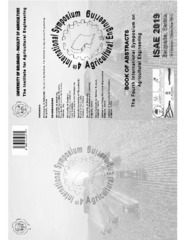Приказ основних података о документу
Soil tillage adjusted to climate changes and maize growing system
| dc.creator | Simić, Milena | |
| dc.creator | Dragičević, Vesna | |
| dc.creator | Kresović, Branka | |
| dc.creator | Brankov, Milan | |
| dc.creator | Dolijanović, Željko | |
| dc.creator | Dumanović, Zoran | |
| dc.date.accessioned | 2022-10-24T07:10:13Z | |
| dc.date.available | 2022-10-24T07:10:13Z | |
| dc.date.issued | 2019 | |
| dc.identifier.isbn | 978-86-7834-341-4 | |
| dc.identifier.uri | http://rik.mrizp.rs/handle/123456789/1018 | |
| dc.description.abstract | Soil tillage is an important component of crop growing system. Nowadays, it has to be aligned with the climate changes, soil type and maize growing technology aimed to produce high, stable and quality yield together with agro-ecosystem prevention. The other measures such as irrigation, fertilization and herbicide application are also important and could contribute to maize grain quality and added nutritional value. No-till systems in semi-arid environments have depended on herbicides and urea to manage weeds and supply plant N needs. However, over time herbicide weed resistance has become a concern that has forced producers to revert to conventional practices. In addition, long-term synthetic fertilizer use has led to stratification of nutrients and pH issues which may result in tillage implementation. The long- term experiment has been conducted in Maize Research Institute Zemun Polje for more than 38 years with no-tillage, reduced and conventional systems of soil tillage together with fertilizers application in different rates and under irrigated and rain feed conditions. The system of the conventional soil cultivation is meant autumn plowing at a depth of 20-25 cm and a pre-sowing seedbed preparation at a depth of 10-12 cm; reduced treatment was conducted by rotovator while direct sowing in no-tillage soil system was conducted by special planter John Deere 7200 (John Deere, USA). Fertilizers are incorporated in the autumn before plowing in the amount of 50 kg ha-1 N, 50 kg ha-1 P and 50 kg ha-1 K in both treatments, while the third variant was without fertilization et al. In the spring, before pre-sowing soil preparation, the additional amounts of N -180 and 240 kg ha-1 were added in treated plots. The long-term experiment results showed considerable differences in maize grain yield in dependence on the applied soil tillage system. In average for twelve years, 2005-2016, maize yield was in no-tillage, reduced and conventional tillage of soil, higher by more than 2 t ha-1 in the rain feed -7.0,8.3 and 10.0 t ha-1 than underirrigated treatment 9.1, 10.5 and 11.9 t ha-1. Under rain feed conditions, during 2016-2018 period, the highest maize grain yield was observed under conventional tillage (9.19 t ha-1) and with fertilizer application in higher amount (8.46 t ha-1). Intensification of soil tillage systems and nitrogen fertilization, contributing to an increase in yield as well as protein content, carotenoids, phytic phosphorus, glutathione and phenols in maize grain. Since the values of analyzed quality parameters in grains did not differ significantly between pre-sowing application of 180 and 240 kg of N, it can be concluded that the optimum amount of N application could be somewhat less than 240 kg ha-1, while the system of conventional tillage in agro-ecological conditions of Zemun Polje most effectively contribute to achieving higher maize yields with better quality. | sr |
| dc.language.iso | en | sr |
| dc.publisher | Beograd : Univerzitet u Beogradu, Poljoprivredni fakultet | sr |
| dc.rights | openAccess | sr |
| dc.rights.uri | https://creativecommons.org/licenses/by/4.0/ | |
| dc.source | 4. International symposium on agricultural engineering "ISAE-2019", Beograd, 31.10-02.11.2019. - Book of abstracts | sr |
| dc.subject | cultivation | sr |
| dc.subject | maize | sr |
| dc.subject | tillage | sr |
| dc.subject | yield | sr |
| dc.title | Soil tillage adjusted to climate changes and maize growing system | sr |
| dc.type | conferenceObject | sr |
| dc.rights.license | BY | sr |
| dc.citation.spage | 39 | |
| dc.citation.epage | 40 | |
| dc.identifier.fulltext | http://rik.mrizp.rs/bitstream/id/4880/12.2019.pdf | |
| dc.identifier.rcub | https://hdl.handle.net/21.15107/rcub_rik_1018 | |
| dc.type.version | publishedVersion | sr |


